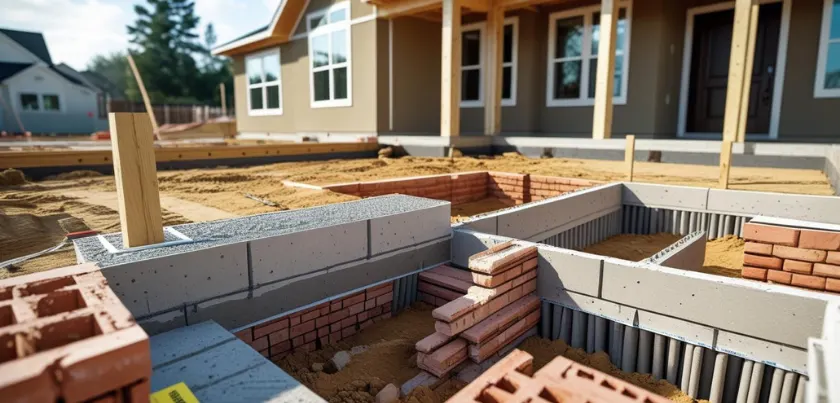Foundation Types for Residential Buildings Explained

When you plan to build your dream home, one of the most crucial aspects is choosing the right foundation type. The foundation ensures your building stands strong for decades, bearing all structural loads safely. At Shree Constructions & Interior, we prioritise structural safety by selecting foundation types best suited to your plot’s soil conditions, design, and budget. understand different residential foundation types, their advantages, applications, and cost considerations.
Why is Foundation Selection Important?
- It transfers the weight of the building safely to the ground
- Prevents differential settlement or structural cracks
- Increases durability during natural disasters like earthquakes or floods
- Reduces future maintenance and repair costs
Choosing the wrong foundation can lead to structural instability, cracks in walls, uneven flooring, and even building collapse in extreme cases.
Key Factors Influencing Foundation Selection
At Shree Constructions & Interior, our engineers analyse:
- Soil type & bearing capacity (SBC) – clay, sandy, rocky, black cotton soil
- Load of the structure – single-floor, duplex, or multi-storey
- Water table level – high water table areas need deeper foundations
- Plot slope and surrounding structures
Types of Foundations Used in Residential Construction
Let’s understand the most common foundation types used for Indian homes:
A. Shallow Foundations
Shallow foundations are used when strong soil is available at a depth of up to 3 metres. They are cost-effective and suitable for most residential homes.
1. Isolated Footing (Pad Footing)
Individual footings under each column to distribute load safely to the soil.
When used:
- Single or double-storey homes
- Soils with good bearing capacity
Advantages:
- Simple and economical
- Easy to construct
- Less material required
2. Combined Footing
A single footing supporting two or more columns close to each other.
When used:
- Columns are too close, and isolated footings overlap
- Near plot boundaries where footing extension is restricted
Advantages:
- Distributes load evenly
- Saves space and excavation cost
3. Strap Footing (Cantilever Footing)
Two isolated footings connected by a strap beam to balance load.
When used:
- Near property boundaries
- Where eccentric loads need balancing
Advantages:
- Prevents differential settlement
- Useful in restricted plot areas
4. Raft Foundation (Mat Foundation)
A single thick concrete slab covering the entire building footprint, supporting all columns and walls.
When used:
- Weak soil with low bearing capacity
- Heavy load structures like multi-storey apartments
Advantages:
- Reduces differential settlement
- Acts as a rigid platform distributing load uniformly
- Provides better resistance against earthquakes
B. Deep Foundations
Deep foundations are used when strong soil is not available at shallow depths, or for heavy structures needing deeper load transfer.
5. Pile Foundation
Long cylindrical columns (piles) driven deep into the ground to transfer load to a firm soil layer or rock.
Types of piles:
- End-bearing piles: Transfer load to strong soil or rock at the bottom.
- Friction piles: Transfer load along the pile surface by skin friction.
When used:
- Weak or compressible surface soil
- High-rise buildings
- Waterlogged or coastal areas
Advantages:
- Suitable for deep weak soil
- High load carrying capacity
- Minimum settlement
6. Pier Foundation
What it is:
Similar to pile foundation but constructed by excavating holes and filling them with concrete piers.
When used:
- For medium-depth foundations
- Where piles are not economical
Advantages:
- Less expensive than piles
- Easier construction in rocky soil
7. Well Foundation (Caisson)
Hollow well-like foundations sunk into the ground, commonly used in bridges but occasionally in large building projects near water bodies.
When used:
- Underwater constructions
- Riverfront residential projects
Which Foundation is Best for Your Home?
Here’s a simplified guide:
| Condition | Recommended Foundation |
|---|---|
| Good soil, single-floor house | Isolated footing |
| Poor soil, heavy structure | Raft or pile foundation |
| High water table area | Pile foundation |
| Columns near boundary | Combined or strap footing |
| Rocky terrain | Pier foundation |
Cost Comparison of Foundation Types (Indicative)
| Foundation Type | Approx. Cost (₹/sq ft of built-up area) |
|---|---|
| Isolated Footing | ₹150 – ₹300 |
| Combined Footing | ₹250 – ₹400 |
| Raft Foundation | ₹500 – ₹800 |
| Pile Foundation | ₹1,000 – ₹1,500 |
Note: Costs vary based on soil condition, depth, and design. Always consult your structural engineer for accurate estimation.
Common Foundation Mistakes to Avoid
- Skipping soil testing before finalising foundation type
- Using under-designed footings to save cost
- Poor quality concrete mix or steel in foundations
- Ignoring anti-termite treatment below foundation
- Lack of proper curing leading to cracks
How Shree Constructions & Interior Ensures Strong Foundations
At Shree Constructions & Interior, we provide:
- Detailed soil testing reports before foundation design
- Experienced structural engineers for safe design
- Quality materials and skilled labour for footing casting
- Supervised concreting, curing, and safety standards compliance
- Transparent cost breakdown for foundation works in your BOQ
Final Thoughts
Your home’s strength lies in its foundation quality and type selection. Never compromise on foundation design as it directly affects safety, durability, and lifetime maintenance costs.
Ready to Build a Safe and Strong Home?
Contact Shree Constructions & Interior today for:
- Professional site and soil analysis
- Best-suited foundation design for your plot
- End-to-end construction services with quality and timely delivery
We build homes on strong foundations of trust, safety, and excellence.
Contact Shree Constructions & Interior Today!
Company Name: Shree Constructions & Interior
Company Address: 215, Ground Floor, Pocket 2, Block F, Sector 16, Rohini, Delhi, 110089
Company Phone No: +91-9355482982
